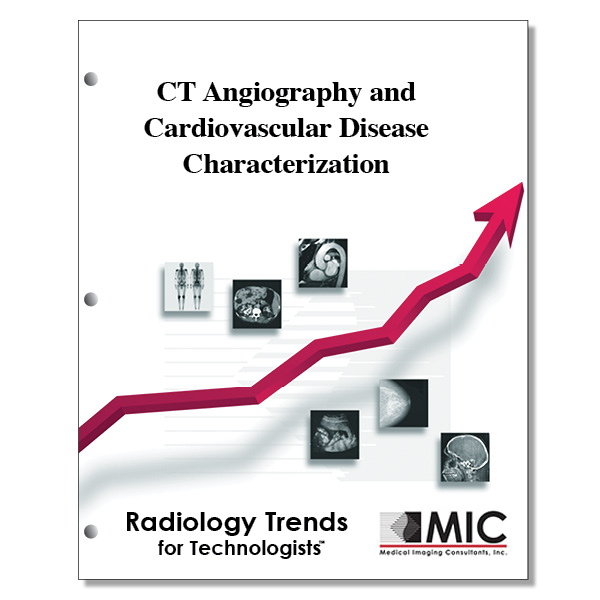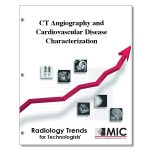

CT Angiography and Cardiovascular Disease Characterization
A review of the evolution of CT angiography from its development and early challenges to a maturing modality that has provided unique insights into cardiovascular disease and management.
Course ID: Q00430 Category: Radiology Trends for Technologists Modalities: Cardiac Interventional, CT, Vascular Interventional3.25 |
Satisfaction Guarantee |
$34.00
- Targeted CE
- Outline
- Objectives
Targeted CE per ARRT’s Discipline, Category, and Subcategory classification for enrollments starting after February 24, 2023:
[Note: Discipline-specific Targeted CE credits may be less than the total Category A credits approved for this course.]
Cardiac-Interventional Radiography: 1.50
Patient Care: 0.25
Patient Interactions and Management: 0.25
Procedures: 1.25
Diagnostic and Electrophysiology Procedures: 0.50
Interventional Procedures: 0.75
Computed Tomography: 3.00
Safety: 0.25
Radiation Safety and Dose: 0.25
Image Production: 0.50
Image Formation: 0.25
Image Evaluation and Archiving: 0.25
Procedures: 2.25
Head, Spine, and Musculoskeletal: 0.50
Neck and Chest: 1.50
Abdomen and Pelvis: 0.25
Magnetic Resonance Imaging: 0.50
Procedures: 0.50
Musculoskeletal: 0.50
Nuclear Medicine Technology: 0.25
Procedures: 0.25
Cardiac Procedures: 0.25
Registered Radiologist Assistant: 2.50
Safety: 0.25
Patient Safety, Radiation Protection, and Equipment Operation: 0.25
Procedures: 2.25
Thoracic Section: 1.50
Neurological, Vascular, and Lymphatic Sections: 0.75
Vascular-Interventional Radiography: 0.50
Patient Care: 0.25
Patient Interactions and Management: 0.25
Procedures: 0.25
Vascular Interventional Procedures: 0.25
Outline
- Introduction
- Emergence of CT Angiography
- Computers and Image Processing
- Contributions of CT Angiography to Clinical Practice
- Acute Aortic Syndromes: New Knowledge Redefining Disease Classification
- Peripheral Vascular Disease: Pushing the Envelope for CT Angiography Coverage and Visualization
- Endovascular Aortic Repair
- Wave 1: Aortic Endograft Deployment
- Wave 2: Transcatheter Aortic Valve Implantation
- CT Angiography of Coronary Artery Disease: The Final Frontier
- Myocardial Perfusion
- Estimating Lesion-Specific Ischemia from Resting CT Angiography
- Concerns for Radiation
- Summary
Objectives
Upon completion of this course, students will:
- be familiar with traditional methods for diagnosis and characterization of vascular disease
- identify the strengths of conventional angiography
- be familiar with the history and development of MR angiography
- recognize the significance of the introduction of helical CT
- identify the limitations of early helical CT systems
- be familiar with the CT advancements that expanded the clinical application of CT angiography
- be familiar with multidetector CT technology
- recognize the current standards for state-of-the-art CT systems
- understand the application of Moore’s law
- be familiar with AAS
- be familiar with intramural hematoma
- understand the CT advancements that led to reclassification of AAS
- be familiar with PAU
- identify the CT FOV for anatomic coverage for adult lower extremity imaging
- understand the limitations for displaying cardiovascular CT data sets
- understand the role of MRI angiography
- identify the commonly used methods for diagnosing PAD in the lower extremity
- be familiar with the categories of PAD
- be familiar with the advantages of CT angiography vs. MRI angiography
- understand the advantages of using dual-energy CT systems
- be familiar with the introduction of endovascular repair of the aorta
- identify the demands on preoperative imaging for stent-graft replacement
- be familiar with the traditional method of sizing an endograft
- be familiar with the use of MRI to detect endoleaks
- be familiar with the TAVR procedure
- identify the researchers responsible for introducing the TAVR approach
- understand the primary cause of paravalvular regurgitation using the TAVR approach
- be familiar with the first CT method for performing CT coronary angiography
- identify the use of ECG-triggering and ECG-gated tube current pulse to lower radiation exposure
- be familiar with the diagnostic characteristics of CT studies employing a low-radiation-dose technology
- be familiar with the radiation levels using low-radiation-dose CT techniques
- understand the role of CT angiography in the ER setting
- identify the primary concerns limiting the use of CT for routine coronary CT angiography
- be familiar with the traditional modality for first-line cardiac function assessment
- understand the performance characteristics of coronary CT angiography
- be familiar with the emerging strategies for improving the characteristics of coronary CT angiography
- be familiar with the current limitation of using myocardial attenuation patterns to assess myocardial perfusion
- compare the advantages of using FFTCT
- be familiar with radiation concerns due to CT utilization
- identify the use of iterative reconstruction techniques to lower radiation exposure
